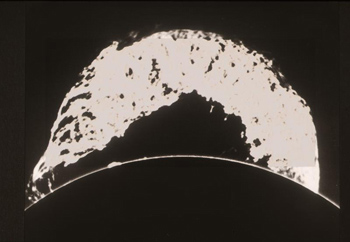The story behind spicules
Plasma jets could be key to coronal mystery
Mar 11, 2011 - by Staff
Mar 11, 2011 - by Staff
Rachael Drummond | 11 March 2011 • One of the most enduring mysteries in solar physics is why the Sun’s outer atmosphere, or corona, is millions of degrees hotter than its surface. Now scientists believe they have discovered a major source of hot gas that replenishes the corona: narrow jets of plasma, known as spicules, shooting up from just above the Sun’s surface. The finding addresses a fundamental question in astrophysics: how energy moves from the Sun’s interior to create its hot outer atmosphere.

NCAR's Scott McIntosh has been examining whether spicules might help explain the extreme heat of the solar corona.
“It’s always been quite a puzzle to figure out why the Sun’s atmosphere is hotter than its surface,” says Scott McIntosh, a solar physicist at NCAR’s High Altitude Observatory and a coauthor of the study. “By identifying that these jets insert heated plasma into the Sun’s outer atmosphere, we gain a greater knowledge of the corona and possibly improve our understanding of the Sun’s subtle influence on Earth’s upper atmosphere.”
The new study, published in January in Science, was conducted by scientists from Lockheed Martin’s Solar and Astrophysics Laboratory (LMSAL), NCAR, and the University of Oslo. It was supported by NASA and the National Science Foundation, NCAR’s sponsor.
The research team focused on spicules, which are fountains of plasma propelled upward from near the surface of the Sun into its outer atmosphere. For decades scientists thought that spicules might be sending heat into the corona. However, following observational research in the 1980s, it was found that spicule plasma did not reach coronal temperatures, and so this line of study largely fell out of vogue.
“Heating of spicules to millions of degrees has never been directly observed, so their role in coronal heating had been dismissed as unlikely,” says Bart De Pontieu, the lead author and a solar physicist at LMSAL.
In 2007, De Pontieu, McIntosh, and colleagues identified a new class of spicules that moved much faster and were shorter lived than the traditional spicules, which have speeds between 20 and 40 kilometers per second (12–24 miles/sec) and lifespans of 3 to 7 minutes. These Type II spicules shoot upward at high speeds, often in excess of 100 km/sec (60 miles/sec), before disappearing. The rapid disappearance of these jets suggested that the plasma they carried might get very hot, but direct observational evidence of this process was missing.
In the Science paper, the researchers used new observations from the Atmospheric Imaging Assembly on NASA’s recently launched Solar Dynamics Observatory and its Focal Plane Package for the Solar Optical Telescope (SOT) on the Japanese Hinode satellite.

Left: Portion of the solar disk as viewed by NASA’s Solar Dynamics Observatory satellite on the morning of 25 April 2010. Center: A close-up of the solar limb, showing the area outlined in the left-hand image, including the solar corona (outer atmosphere). Right: The same area of the limb, with white and black areas indicating motion. Spicules themselves are so faint that scientists use images like this to see disturbances associated with spicules as they emerge (in white) and in their wake (in black). The spicules streak upward from the solar surface at speeds often greater than 100 kilometers per second (60 miles/sec). Some of the spicules’ plasma (ionized gas), at temperatures in excess of one million kelvins, flows up into the corona. Here is a larger version of the image. (Images courtesy NASA’s Solar Dynamics Observatory, Atmospheric Imaging Assembly.)
“The high spatial and temporal resolution of the newer instruments was crucial in revealing this previously hidden coronal mass supply,” says McIntosh. “Our observations reveal, for the first time, the one-to-one connection between plasma that is heated to millions of degrees kelvin and the spicules that insert this plasma into the corona.”
The findings provide an observational challenge to existing theories of coronal heating. During the past few decades, scientists have proposed a wide variety of theoretical models, but the lack of detailed observation has significantly hampered progress. “One of our biggest challenges is to understand what drives and heats the material in the spicules,” says De Pontieu.
A key step, he adds, will be to better understand the interface region between the Sun’s visible surface, or photosphere, and its corona. Another NASA mission, the Interface Region Imaging Spectrograph (IRIS), is scheduled for launch in 2012. IRIS will provide high-fidelity data on the complex processes and enormous contrasts of density, temperature, and magnetic field between the photosphere and corona. Researchers hope this will reveal more about the spicule heating and launch mechanisms.

While spicules have gained much attention recently, a far larger solar phenomenon observed for decades may be related. Prominences, suspensions of cool gas that are magnetically rooted in the Sun’s photosphere, can extend many thousands of miles into the solar corona.
Shown above in its early stages is a prominence photographed on 4 June 1946 from Climax, Colorado, by Walter Orr Roberts, the founding director of NCAR, UCAR, and the High Altitude Observatory. Within about an hour, this prominence became nearly as long as the Sun’s diameter, 1.39 million kilometers (865,000 miles)—the largest prominence ever documented up to that point. In a few more hours, it disappeared completely.
“It’s not clear how spicules relate to prominences,” NCAR solar physicist Scott McIntosh says. It does appear that the two interact within the corona, however.
“While spicules might not be responsible for the formation of the magnetic scaffold of the prominence, it’s highly likely that plasma cooling out of the corona is the largest contributor,” says McIntosh. “It’s also likely that some of this plasma is inserted into the corona by spicules and then ‘rains’ out of the corona, cooling and falling into the tangled magnetic plasma trap of the prominence.”